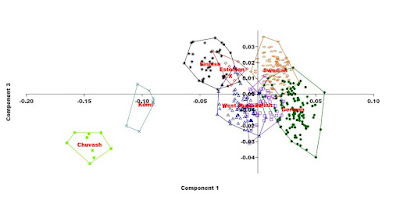The auctor is a known Finnish geneticist and the article header is "where did the Finnish genome come from". It is in Finnish, so it is not useful to undergo the text, instead of it I try to analyse pictures in general level. The summary follows subjects of Finnish genetic research and gives a good picture about the situation we have now. There are some old standpoints or approaches which I'll list first. I try to evaluate these things and list obvious problems in Finnish studies.
1 Strong connection between language and genes
I understand that the pressure on this point of view is strong, because Finno-Ugric people are a small minority in Eurasia. This has been obvious. Has this matter been too strong and impeded the research?
2 The viewpoint about the unique Finnish genome
Usually this idea is explained by the isolated geographic situation of Finland. Actually Finland has been widely open to the east, in a comparable amount to Estonia and other Baltic countries, yet western cultural connections have been strong.
3 After that (unique Finnish genome) a bit strangely Finnish studies underline the diversity of Finnish uniparental genetic lines.
A big dilemma has been why the mitochodrial dna shows high diversity in Finland. I havn't seen explanations; sometimes it is explained by western connections, sometimes by eastern connections. Also, the yDna shows both western and eastern origins. IMO the research has not even tried to find explanations.
4 Explaining differences of domestic genetic diversity by historic events instead of prehistoric events. In Finland the historic time starts after the 12th century. The Finns are seen as a unique population with unique root. But one of the most popular idea in Finnish research have been to underline the historic era east-west bifurcation of the Finnish population, based on the PEACE TREATY OF OREKHOVETS (TREATY OF NÖTEBORG, Pähkinäsaaren rauha in Finnish) in 1323. This sounds weird, because this border was valid only a bit more than 200 years and even the most pheripheral regions of the eastern side were returned to the Finnish speaking entity only 300 years later, in the beginning of the 17th century. How can the difference have been resulted in 200-300 years? Mostly the explanation has been the Karelian influence in the eastern Finland, but Karelian language has never been spoken in Finland to a larger extent.
The introduction in this summary challenges old standpoints to some extent. I translated introduction and core observations, but if you are more interested in latest reckonings I recommend to translate the text.
Here is the link to the article.
Google translation.
Introduction
In medical genetics studies, the Finnish population is used as an isolate and homogeneous. Neither is exactly true. Modern and ancient DNA studies have shown, that people have come here with their genes from different directions throughout the millennia. So we're on inherits mostly from the west, but about a dozen also from the far east; that's how it got from post-glacial hunter-gatherers, early potters, early farmers like bronze from Siberia as well. The genetic peculiarity of Finns is that in Finland small population and recent bottlenecks have resulted in genetic drift that is swayed the frequencies of many genetic forms to the rest of Europe in general. Also within Finland there is a strong genetic dividing line between western and eastern - or southwestern and northeastern between Finland.
Core observations
Ancient DNA studies have shown that new inhabitants have come to the surrounding areas of Finland through prehistory.
The majority of what modern Finns inherit is of western origin.
Speakers of Finland's eastern relative languages with we only have a common genetic heritage a few percent.
Eastern and Western Finns differ genetically distinct from each other more than many Central European populations.
The East-West difference and its genetic distinctiveness is largely due to the population boom periods in history from the bottle necks and the small population.
Picture 1 presents now available ancient samples. Unfortunately southwestern Finnish autosomal samples described in my previous post are not yet available and present in this paper. Those samples are first autosomal samples representing prehistoric Finnish people.
Picture 2 presents a PCA plot showing certain selected samples. Unfortunately the plot lack of western (Scandinavia, Gotland, Poland) and eastern (Russia) Iron Age samples. Only Estonian and Finnish Iron Age samples are included and the Finnish ones actually represent Saami people.
(I noticed that the close-up is not analogous to the wide picture)
Picture 3. Used methods are not specified. Results differ somewhat from the admixture analysis of Tambets 2018, but the difference is not in any way essential.
Picture 5 shows the west-east dichotomy in Finland. I have not seen explanations why this happens. What is the historical reason to this dichotomy? Obviously it can't be a short-term peace treaty between Sweden and Novgorodian Russia. It is said that the dichotomy is a result of the Karelian origin of East Finns, but what I have seen the suggested Karelian source population came from the Karelian Isthmus and they resemble today more Southwest Finns than Eeast Finns. Misunderstanding is caused by the academic Karelian sample set got from Russia, which is from the White Sea region rather than from Karelian Isthmus.





















